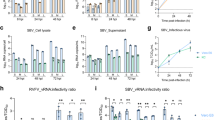Summary
Conditions suitable for immunogold detection of digoxigenin-labelled DNA probes hybridized to parvovirus B19-infected erythroid cells embedded in Lowicryl K4M and LR White acrylic resins were established at the electron microscope level. The protocol was initially optimized using a positive control probe for whole human DNA which produced signal over the heterochromatin of all nucleated cells. In cultures harvested 2 days postinfection, B19 nucleic acid was detected mainly within the centrinuclear region of erythroid cells exhibiting characteristic margination of the chromatin. The B19 hybridization signal was largely unaffected by denaturation and was resistant to RNase digestion but sensitive to DNase digestion, indicating that it was mainly single-stranded B19 DNA. Relatively few gold particles were found over crystalline arrays of viral capsids, consistent with the observation that they are composed of mainly ‘empty’ capsids. B19 nucleic acid was detected in apparent transit from nucleus to cytoplasm through pores in the nuclear membrane. While the sensitivity of this system is limited by the fact that hybridization occurs only at the surface of the section, it is a rapid and specific means of localizing viral nucleic acids with a high degree of resolution.
Similar content being viewed by others
References
Beals, T. F. (1992) Ultrastructure of in situ hybridization. Ultrastruct. Pathol. 16, 87–93.
Binder, M. S., Tourmente, S., Roth, J., Renaud, M. & Gehring, W. J. (1986) In situ hybridization at the electron microscope level: localization of transcripts on ultrathin sections of Lowicryl K4M-embedded tissue using biotinylated probes and protein A-gold complexes. J. Cell Biol. 102, 1646–53.
Fleming, K. A. (1992) Analysis of viral pathogenesis by in situ hybridization (editorial), J. Pathol. 166, 95–6.
Fleming, K. A., Evans, M., Riley, K. C., Franklin, D., Lovell-Badge, R. H. & Morey, A. L. (1992) Optimisation of non-isotopic in situ hybridization on formalin-fixed paraffin-embedded material using digoxigenin labelled probes and transgenic tissues. J. Pathol. 167, 9–17.
Fournier, J. G., Escaig, H. F. & Grigoriev, V. (1991) Ultrastructural detection of cellular and viral RNA with biotinylated DNA probes. Bull Assoc. Anal. Nancy 75, 13–5.
Harris, J. W. (1992) Parvovirus B19 for the haematologist. Am J. Hematol. 39, 119–30.
Morey, A. L. & Fleming, K. A. (1992) Immunophenotyping of fetal haemopoietic cells permissive for human parvovirus B19 replication in vitro. Br. J. Haematol. 82, 302–9.
Morey, A. L., Fleming, K. A., Del Buono, R. & Chandler, J. A. (1991a) A flexible method for non-isotopic in-situ labelling of multiple nucleic acid and antigenic targets in individual cells or sections. J. Pathol. 163, 159A.
Morey, A. L., Taatjes, D., Leslie, K. & Fleming, K. A. (1991b) In situ hybridization at the ultrastructural level with digoxigenin labelled probes. J. Pathol. 164, 356A.
Morey, A. L., Ferguson, D. J. P. & Fleming, K. A. (1993) Ultrastructural features of fetal erythroid precursors infected with parvovirus B19 in vitro: evidence of cell death by apoptosis. J. Pathol. 169, 213–20.
Puvion-Dutilleul, F. & Puvion, E. (1989) Ultrastructural localization of viral DNA in thin sections of herpes simplex virus type 1 infected cells by in situ hybridization. Eur. J. Cell Biol. 49, 99–109.
Puvion-Dutilleul, F. & Puvion, E. (1990) Analysis by in situ hybridization and autoradiography of sites of replication and storage of single- and double-stranded adenovirus type 5 DNA in lytically infected HeLa cells. J. Struct. Biol. 103, 280–9.
Puvion-Dutilleul, F. & Puvion, E. (1991) Ultrastructural localization of defined sequences of viral RNA and DNA by in situ hybridization of biotinylated DNA probes on sections of herpes simplex virus type 1 infected cells. J. Electron Microsc. Tech. 18, 336–53.
Roth, J. (1982) The protein A-gold (pAg) technique - qualitative and quantitative approach for antigen localization on thin sections. In Techniques in Immunocytochemistry (edited by Bullock, G. R. & Petrusz, P.) Vol 1, pp. 108–30. London: Academic Press.
Roth, J., Bendayan, M., Carlemalm, E., Villiger, W. & Garavito, M. (1981) Enhancement of structural preservation and immunocytochemical staining in low temperature embedded pancreatic tissue. J. Histochem. Cytochem. 29, 663–71.
Slot, J. & Geuze, H. J. (1985) A new method of preparing gold probes for multiple-labelling cytochemistry. Eur. J. Cell Biol. 38, 87–93.
Troxler, M., Pasamontes, L., Egger, D. & Bienz, K. (1990) In situ hybridization for light and electron microscopy: a comparison of methods for the localization of viral RNA using biotinylated DNA and RNA probes. J. Virol. Meth. 30, 1–14.
Wenderoth, M. P. & Eisenberg, B. R. (1991) Ultrastructural distribution of myosin heavy chain mRNA in cardiac tissues: a comparison of frozen and LR White embedment. J. Histochem. Cytochem. 39, 1025–33.
Wolber, R. A., Beals, T. F., Lloyd, R. V. & Maassab, H. F. (1988) Ultrastructural localization of viral nucleic acid by in situ hybridization. Lab. Invest. 59, 144–51.
Wolber, R. A., Beals, T. F. & Maassab, H. F. (1989) Ultrastructural localization of herpes simplex virus RNA by in situ hybridization. J. Histochem. Cytochem. 37, 97–104.
Young, N., Harrison, M., Moore, J., Mortimer, P. & Humphries, R. K. (1984) Direct demonstration of the human parvovirus in erythroid progenitor cells infected in vitro. J. Clin. Invest. 74, 2024–32.
Author information
Authors and Affiliations
Rights and permissions
About this article
Cite this article
Morey, A.L., Ferguson, D.J.P., Leslie, K.O. et al. Intracellular localization of parvovirus B19 nucleic acid at the ultrastructural level by in situ hybridization with digoxigenin-labelled probes. Histochem J 25, 421–429 (1993). https://doi.org/10.1007/BF00157806
Received:
Revised:
Issue Date:
DOI: https://doi.org/10.1007/BF00157806




